Techniques for Artificial Hybridization
Walter R. Fehr and Walter P. Suza
Readings:
- Chapter 13: Techniques for Artificial Hybridization [pdf], Principles of Cultivar Development. Vol. 1: Theory and Technique, by Walter R. Fehr (Access the full book)
- Chapter 14: lnterspecific Hybridization [pdf], Principles of Cultivar Development. Vol. 1: Theory and Technique, by Walter R. Fehr
- Chapter 1: Environmental Effects on Flowering [pdf], Hybridization of Crop Plants, Walter R. Fehr and Henry H. Hadley (Eds.) (Access the full book)
Introduction
The first step in cultivar development is obtaining segregating populations from which superior individuals can be selected. Chapter 2 covered the selection of parents that could be used for hybridization to form a segregating population. In Chapter 3, the various types of segregating populations and the field layouts for mating parents were discussed. The purpose of this chapter is to understand the procedures used to obtain hybrid seed from the mating of selected parents for a breeding program. The production of hybrid seed for developing segregating populations is not done in the same manner as the production of seed of hybrid cultivars for sale to end users. The production of commercial quantities of seed of hybrid cultivars will be covered in Principles of Cultivar Development.
Artificial hybridization requires knowledge of the species mode of reproduction and the conditions necessary to obtain flowers of the parents at the same time. You will want to review lesson 1 of Agron. 527, and the reading assignment for this lesson to understand the types of flowers and modes of reproduction.
From the perspective of artificial hybridization, the three basic types of flowers are perfect, monoecious, and dioecious. Perfect flowers contain both the male and female organs. Species with monoecious flowers have the female and male organs on different parts of the plant (Figure 1). Species with dioecious flowers have the female and male organs on different plants, for example, buffalograss: (YouTube)
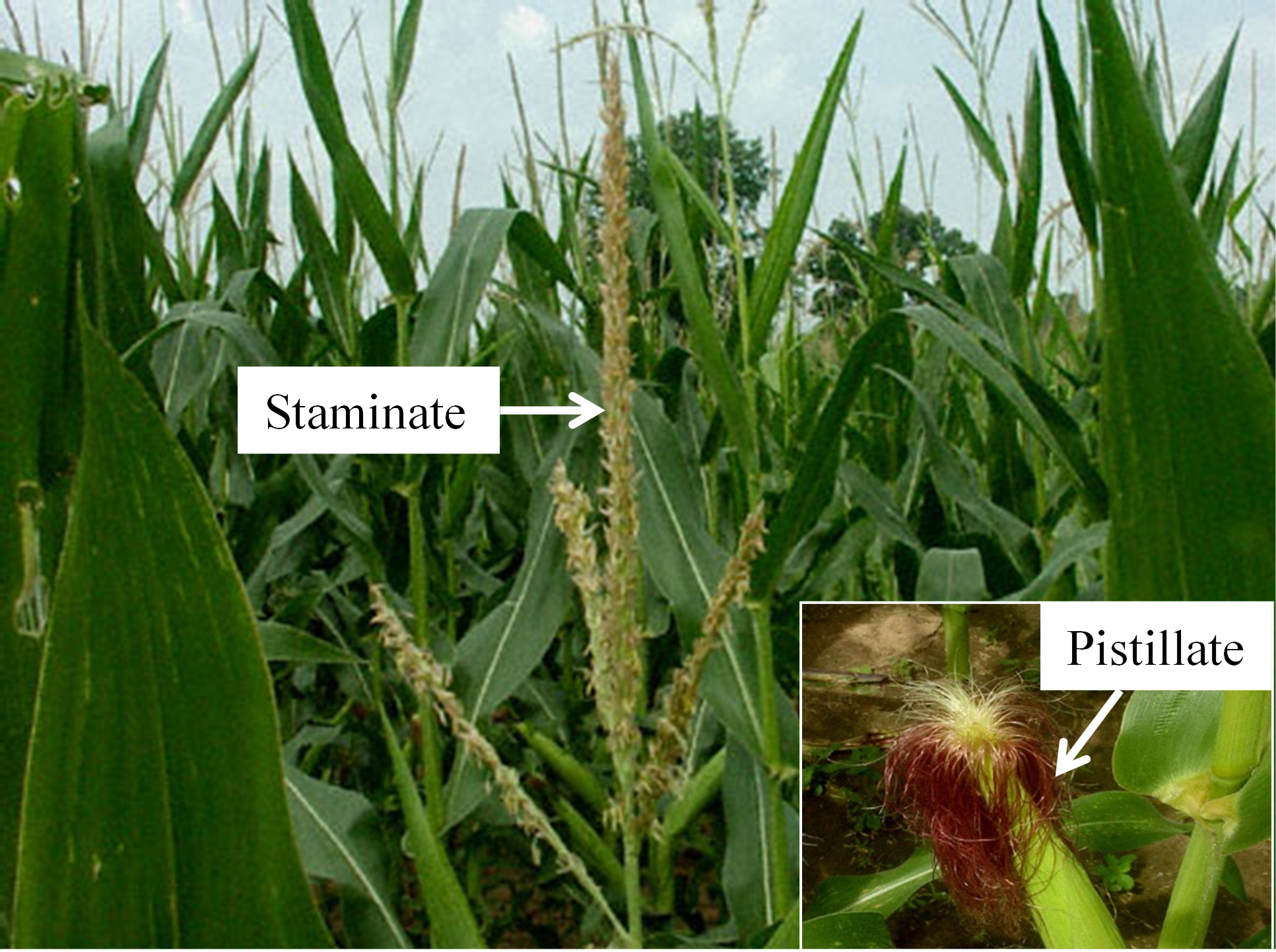
Hybridization of species with perfect flowers
The mating of parents that have perfect flowers can be done with or without manual labor. Manual crossing is done when the floral parts are of adequate size, control of the female and male parents of the hybrid seed is desired, and plants that result from self-pollinated seed can be readily distinguished from hybrid plants. Examples of species that routinely used manual crossing are barley, common bean, field bean, soybean, oat, triticale, canola, and wheat. Figures 2 to 12 illustrate manual crossing in soybean and provide important information about flower anatomical features to be take into consideration in this process.
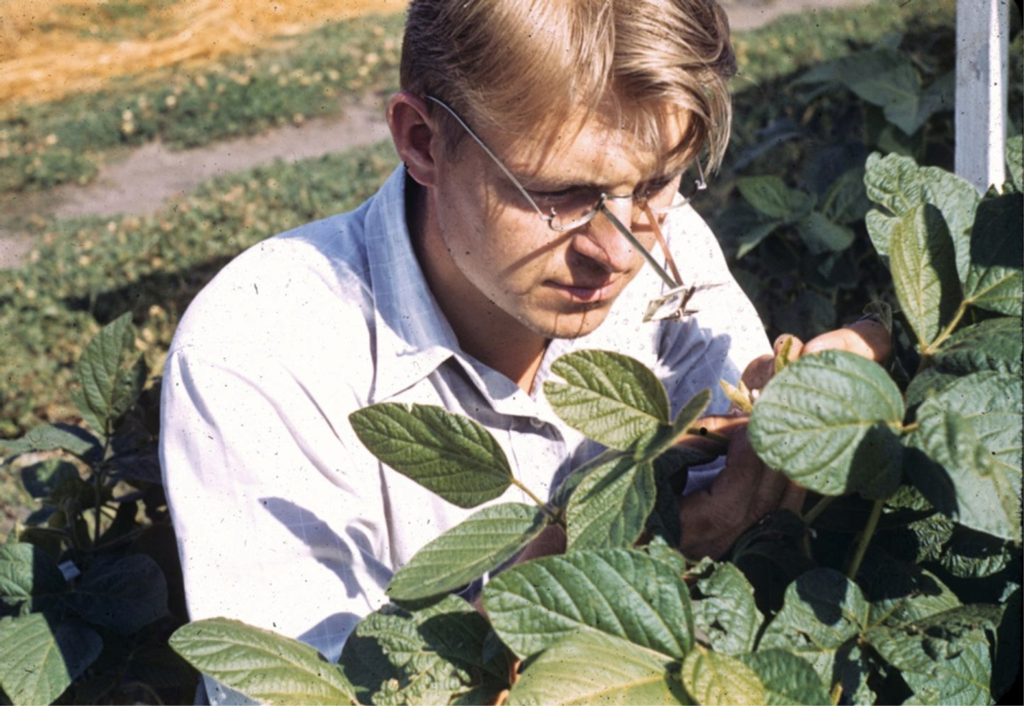
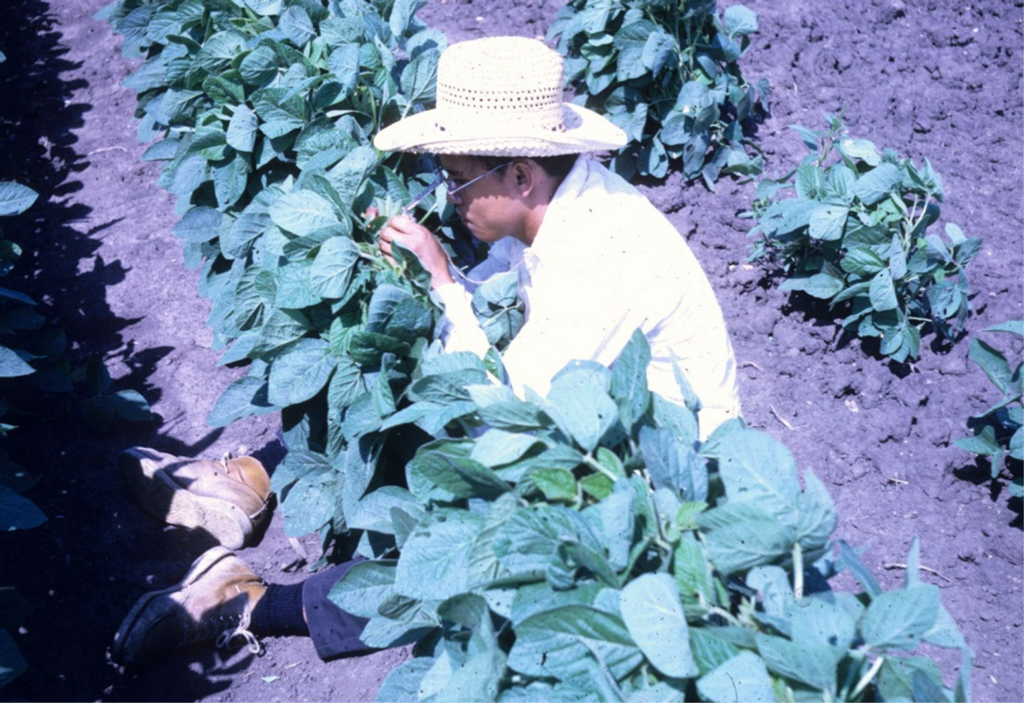
Descriptions of the steps presented in the slides are presented below:
- Figure 4. This flower is at the stage when the female is receptive to pollen, but the anthers are not mature enough to shed pollen. A flower of this stage on the female parent will be used for crossing. All of the flowers at the node that have fully exposed petals and the young buds that will become flowers are removed with a tweezers. This reduces competition for nutrients between the flowers used for crossing and other flowers at the node. Photo courtesy of Walter R. Fehr, Iowa State University.
- Figure 5. The sepals surrounding the petals are removed with a tweezers. The petals of soybean flowers are primarily white (recessive) or purple (dominant). If one parent of a cross is white and the other is purple, the white-flowered plant will be used as the female so that accidental self-pollinations can be readily detected when the hybrid plants are grown. Photo courtesy of Walter R. Fehr, Iowa State University.
- Figure 6. The petals of the flower are removed to expose the reproductive organs. The scar that marks the place where the sepals were removed will be used to differentiate at harvest pods from flowers that were used for artificial hybridization and pods resulting from natural self-pollination that have their full sepals. Photo courtesy of Walter R. Fehr, Iowa State University.
- Figure 7. The female reproductive organ is surrounded by 10 anthers. This flower is ideal to use for crossing because the anthers are not mature enough to shed pollen. As the anthers mature, the filaments increase in length so that the anthers surround the stigma when they shed pollen. Emasculation of the flower is not necessary because if the exposed stigma is not pollinated, it will dry up and be unreceptive by the time the anthers of the flower are mature enough to shed pollen. Photo obtained from Fehr, W.R. 1980. Soybean. p. 593. In W.R. Fehr and H.H. Hadley (eds.) Hybridization of crop plants. The American Society of Agronomy and the Crop Science Society of America, Wisconsin.
- Figure 8. The stigma at the end of the style looks like a drop of water. Photo courtesy of Walter R. Fehr, Iowa State University.
- Figure 9. When the petals of a flower on the male parent are fully exposed, the anthers are ready to shed pollen. Photo obtained from Fehr, W.R. 1980. Soybean. p. 593. In W.R. Fehr and H.H. Hadley (eds.) Hybridization of crop plants. The American Society of Agronomy and the Crop Science Society of America, Wisconsin.
- Figure 10. A tweezer is used to remove the male and female reproductive organs from a flower of the male parent. Note that the anthers are surrounding the stigma. Photo courtesy of Walter R. Fehr, Iowa State University.
- Figure 11. The anthers are gently touched on the stigma so that the pollen is released from the anther. One male flower can be used to pollinate up to three female flowers, if pollen production is good. Photo courtesy of Walter R. Fehr, Iowa State University.
- Figure 12. About seven days after pollination, a pod will be visible if crossing was successful. Only about 50% of the female flowers successfully produce a pod and there are only about two seeds in a pod. This means that on the average only one hybrid seed is obtained from the female flowers used for crossing. The dried stigma at the tip of the pod will remain when the pod is mature. The seed scar from removal of the sepals is clearly visible. Photo obtained from Fehr, W.R. 1980. Soybean. p. 593. In W.R. Fehr and H.H. Hadley (eds.) Hybridization of crop plants. The American Society of Agronomy and the Crop Science Society of America, Wisconsin.
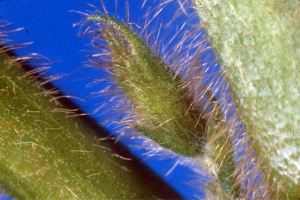
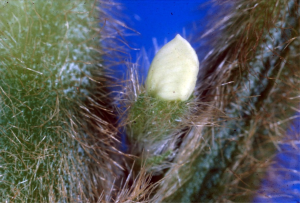
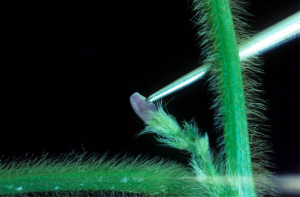
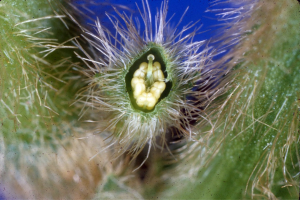
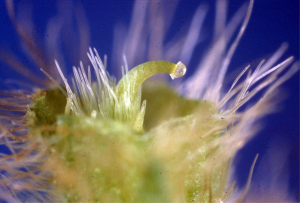

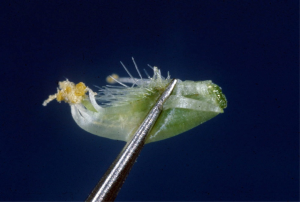
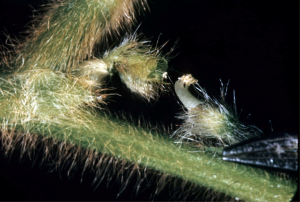
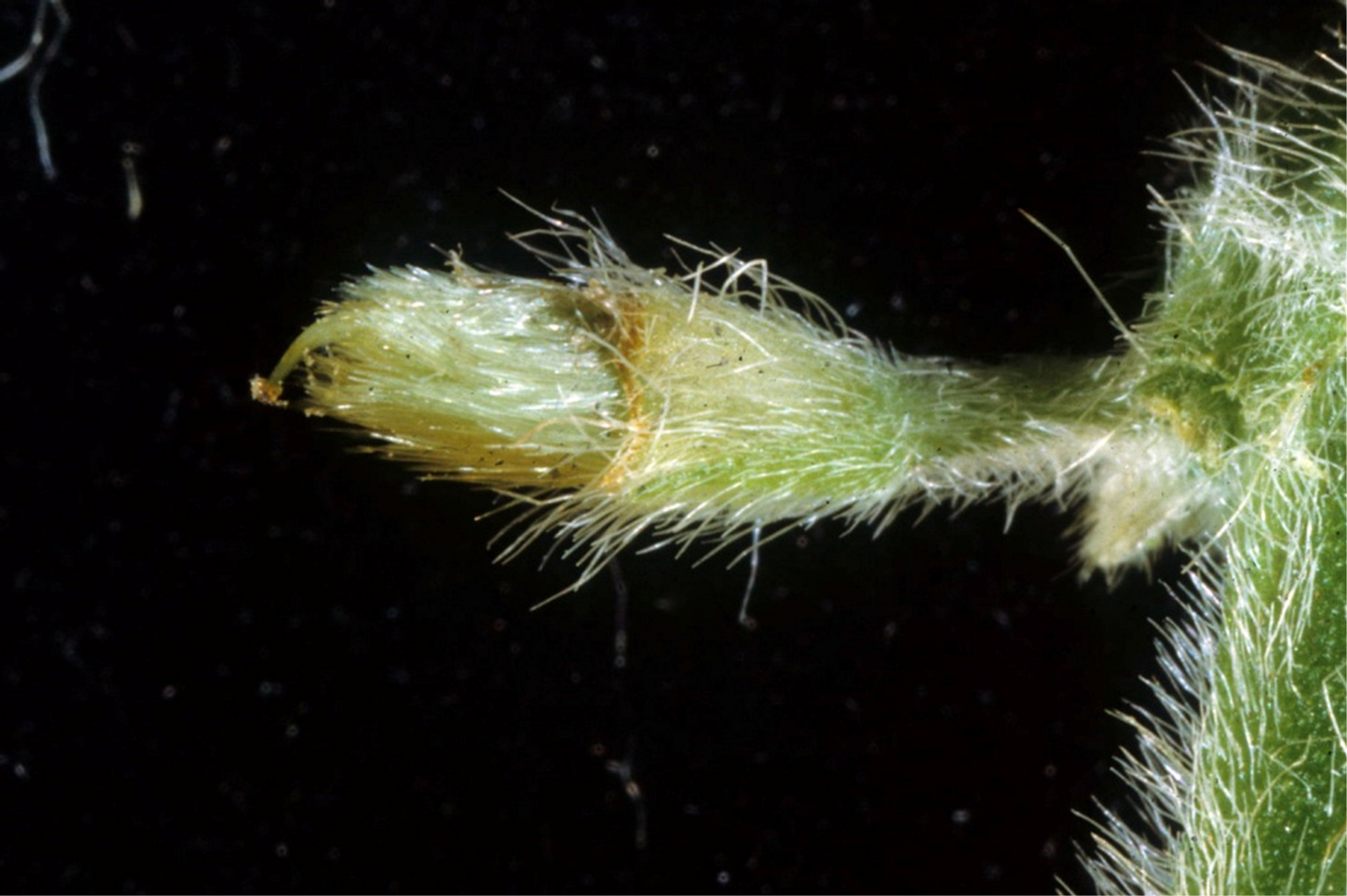
Crossing of parents without manual labor is done when floral parts are extremely small, self-pollination is minimized or eliminated through self-incompatibility or male sterility, cross-pollination is common by wind or insects, and individuals that are the result of self-pollination can be readily distinguished from hybrid individuals. Manual labor is not used for species that routinely use a polycross to mate multiple parents to form a population for selection, as discussed in lesson 4. Examples of species that commonly use a polycross include, alfalfa, bromegrass, orchardgrass, red clover, and switchgrass,
Sugarcane is an example of a species with perfect flowers for which manual labor generally is not used for crossing. The inflorescence of sugarcane, also called a flowering arrow or tassel, consists of thousands of both perfect and imperfect flowers. The imperfect flowers are a result of abortion of either the pistils, but to a greater extent of the stamens. Parental genotypes of sugarcane have a broad variation in fertility and seed production due to male sterility and self-incompatibility.
Parental clones generally are selected before flowering, potted, and maintained in an isolated facility designated for crossing. Manual emasculations generally are not done because too many small flowers are produced per inflorescence and it takes time for the whole arrow to complete flowering. For cross-pollination, breeders commonly select female parents that are largely male sterile. Pollination may be done by placing the arrow of the male parent above the arrow of the female parent so that pollen can fall on the female flowers. Alternatively, pollen may be collected from the flowers of the male parent and dusted over the arrow of the female clone.
If the female parent is male-sterile, only hybrid seed will be obtained. A cross to a male-fertile female will result in the production of both selfed and hybrid seed. Individuals resulting from self-pollination generally will be eliminated during selection because they will not perform well due to inbreeding depression. When available, molecular markers also can be used to distinguish selfed and hybrid individuals.
Hybridization of monoecious species
Watermelon is an example of a monoecious species (Figure 13A) for which manual labor is used for artificial hybridization. In commercial production, watermelon is naturally pollinated by insects. Prior to manual pollination, female flowers may be protected from insect pollinators by using paper clips to restrict buds from opening, covering with foam cups, or small screen cages and nets. The male flowers also may be protected by the same methods used to protect female flowers to prevent contamination by pollen from other plants. It may be unnecessary to protect the flowers of plants grown in greenhouses equipped with structures that exclude insects. The process of hand pollination involves the harvesting of male flowers, opening their petals, and brushing the male flower against the female flower as shown in Figure 14. After pollination, female flowers should remain protected for one day to prevent accidental pollination.

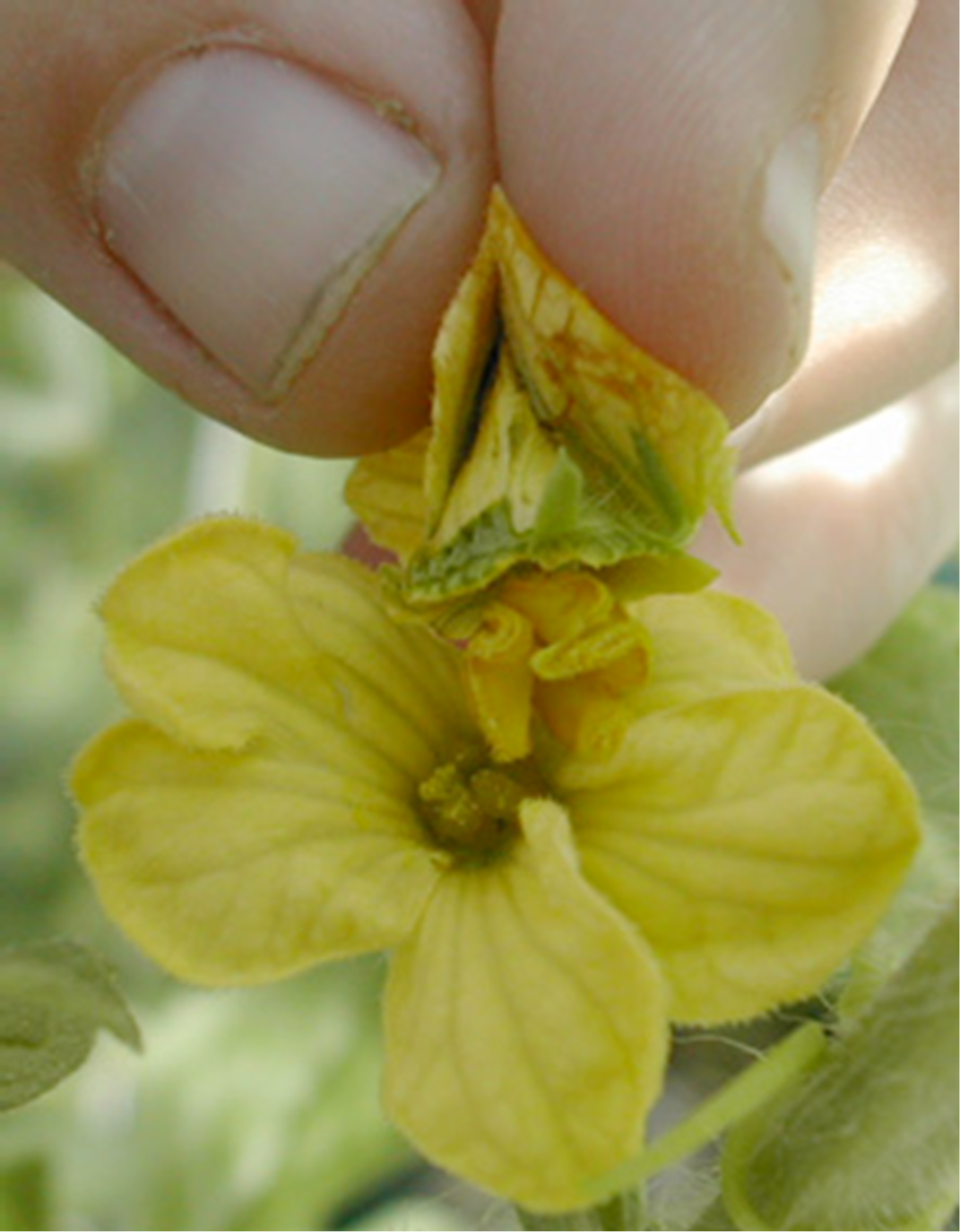
Hybridization of dioecious species
Pistachio is an example of a species for which manual labor is used for artificial hybridization. The following description is based on the article by authors in the Journal of Plant Sciences describing the effects of artificial pollination on pistachio fruit cropping [J. Plant Sci. 2:228-232 (2007)].
The pistachio is naturally wind-pollinated in commercial production. For artificial hybridization female flowers (figure 15A) are normally protected using paper bags before they are fully developed. Male trees normally bloom earlier than when the female flowers are fully mature and ready for pollination; therefore, pollen is collected from the male flowers (figure 15B) and stored at 4oC until the female flowers are ready for pollination. Application of pollen to the female flowers is done using a brush. The pollinated flowers are covered to prevent accidental pollination.

Review Questions
In this assignment, you will use the chapters for the following species from the book Hybridization of Crop Plants: rice, maize, and hop. For each species, briefly describe the following:
| Question | Rice | Maize | Hop |
| (1) Flower structure and distribution on the plant. | |||
| (2) Environmental conditions that control flowering and at least one strategy to get parents to flower at the same time. | |||
| (3) Preparation of the female flower for pollination. | |||
| (4) Collection of male pollen. | |||
| (5) Techniques for pollination. | |||
| (6) Protection of the pollinated flower from contamination. | |||
| (7) Labeling of the pollinated flower. | |||
| (8) Method of harvesting hybrid seed. This refers to hybrid seed obtained by crossing of selected parents for population development, not commercial hybrid seed production. | |||
| (9) Number of seeds generally obtained from one pollination. |
Flowers that have both male and female reproductive parts in the same organ.
Having separate male and female reproductive parts in the same plant.
Having male and female reproductive parts on separate plants.
The removal of male reproductive parts of a perfect flower or a monoecious plant to prevent of self-pollination.

